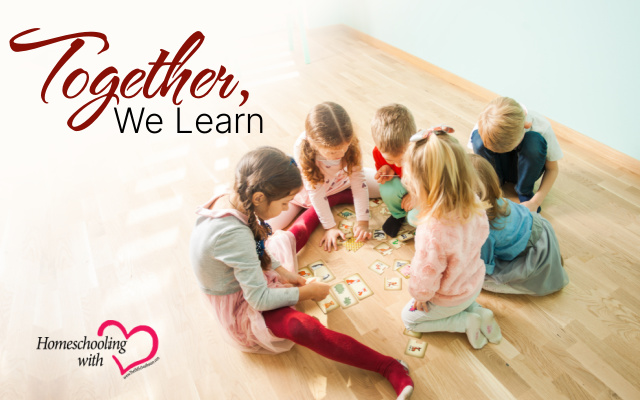Together, We Learn


Visual learners, auditory learners, tactile learners, oh my! The different ways and styles of learning are so diverse and our children with them. Homeschooling is amazing because it allows you to directly create activities that can help your child learn in the way that God created them to learn. To hone those skills that they naturally have. To break through those walls of difficulties in ways that can lead them on the road to success.
Oh, it all sounds so easy! We all know it isn’t, especially when you have a household full of different ages, needs, etc. However, maybe we can come up with some tips and tricks together that can help us accomplish this smoothly.
Technology
Use technology to bridge gaps and help with independence. Screen time???? What?? Those two words have almost become synonymous with negativity. Don’t get me wrong, screen time needs to be monitored and used in a way that the parent feels comfortable and that keeps the child safe. Some parents may not feel comfortable with using screen time at all, and that’s ok. There are so many ways.
However, if you are open to screen time, it’s ok to find reliable resources that can help your child to learn. The key here is to also be involved, even when lessons are given electronically, to be sure your child is not just mindlessly tapping.
Some wonderful resources are CTC Math and Reading Eggs. I use these during times when I need one or more child to be independent so I can have some focused time with another. Then I check in with that child later to go over anything personally.
The big thing with having children doing different things at once is holding them accountable. Finding different mediums to demonstrate knowledge is important, and here, technology can help document when you can’t. Tools like Seesaw, Flipgrid, or just having them take pictures with your phone can help them hold themselves accountable.
Whenever Possible, Group
Yes, yes!!! Different ages and needs can learn together and benefit from it! Help the kids use their strengths to help others where they may still be learning about a skill. Realize I intentionally did not use the terms “older” or “younger” because while age may play a role in mastering in skills, that isn’t always the case. If one has a strength in reading, let them do a read aloud and go over words. If one is strong in math, let them help! Or, and this may sound backwards, let your child teach a lesson in an area they may be weaker in, but help them plan it. Would you like to know how I finally really understood fractions? I taught it! Figure out how your child can do this successfully to increase their confidence. Motivation and confidence are important!
Engage In Sensory Activities
Sensory activities are a great way to sneak in lessons and skills, and everybody can do them. No matter how old you are, who doesn’t love sticking your hands in shaving cream and making a mess? Activities like this allow you to do different skills while using a sensory medium. For example, let’s just stick with shaving cream for a minute. (Because I love it. It smells good, it cleans the table, and I love giving my son a big beard with it.) One child can write ABCs in it, one can be practicing a math problem on it, and your youngest kids can be just making a mess and keeping busy. The opportunities to individualize are endless.
Get Outta Here!
Get out of the house and go on a field trip. Of course, museums, zoo, etc. are all great learning experiences. However, you don’t have to spend a lot of money to have these experiences. Being intentional with your grocery trips, library trips, park trips, etc. are cost-friendly ways to individualize activities that benefit them for life. At the grocery store, one child can make a list while one focuses on decimals and another one can practice reading labels, etc.
One significant thing to remember is you learn plenty of valuable things at home. Doing laundry, cooking, organizing your home, and gardening are all important skills. You can learn science, reading, math, and all of that with these skills, but when you think of the things you need to know every day, these are it. Some kids can sort while some load and put away laundry. Some kids can chop (with supervision or a safety knife) while others set the table or read ingredients.
Make it work for your family and your needs. Every family is uniquely designed, and every parent and child as well. Work together to figure out what works for you, and pick activities that can promote a positive learning experience.
 Candice Parks is a mother of four and a wife of a wonderful husband. She is a former special education teacher who is passionate about discussing the benefits and the blessings of homeschooling your children. The Parks enjoy learning about life, playing games, baking, and reading together as a family. Check out her family’s journey and curriculum reviews on www.instagram.com/parkshomeclassroom.
Candice Parks is a mother of four and a wife of a wonderful husband. She is a former special education teacher who is passionate about discussing the benefits and the blessings of homeschooling your children. The Parks enjoy learning about life, playing games, baking, and reading together as a family. Check out her family’s journey and curriculum reviews on www.instagram.com/parkshomeclassroom.
































